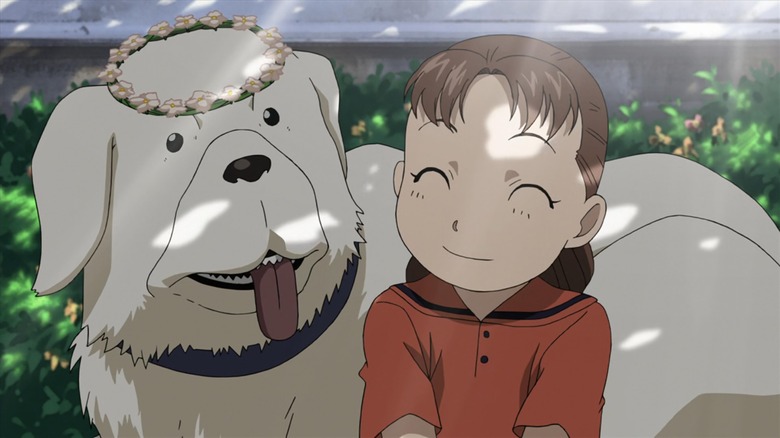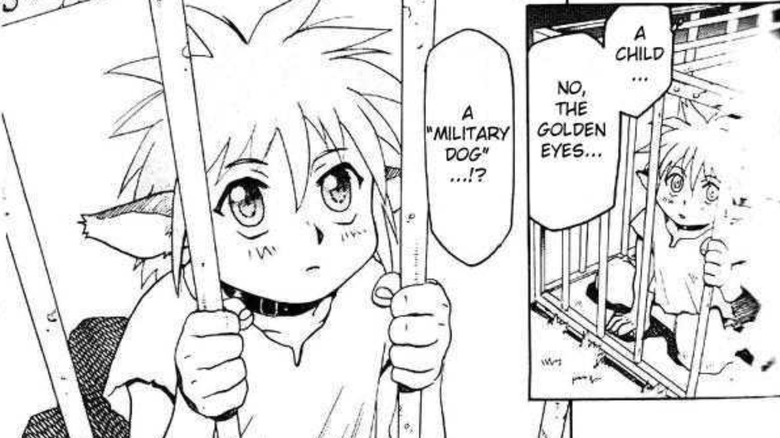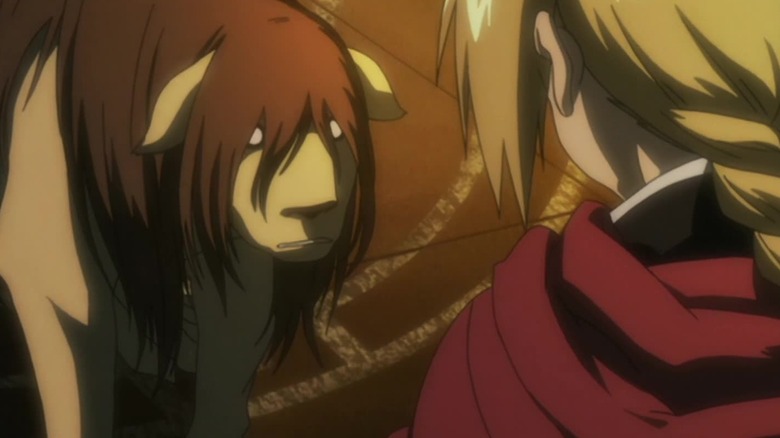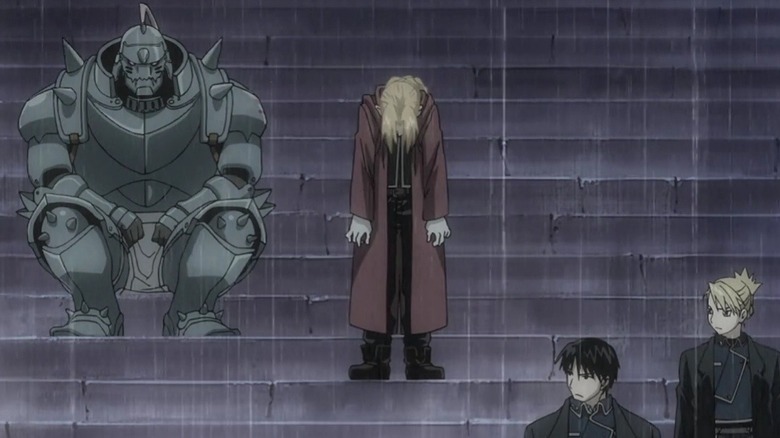Hiromu Arakawa's First Manga Foreshadows The Most Infamous Fullmetal Alchemist Moment
If you're a "Fullmetal Alchemist" fan, you've never forgotten about Nina Tucker. A four-year-old girl and the daughter of State Alchemist Shou Tucker, she's had a lonely life with only her dog Alexander for company. Until the alchemist Elric brothers, Edward and Alphonse, stop by to study with her father. The three form a sibling-like bond — Nina calls the Elrics her "big brothers" — but tragedy is around the corner.
Shou, desperate to create a living chimera that can talk, uses Nina and Alexander as the ingredients. The Elrics are understandably horrified, but changing the monstrosity back into their "little sister" is beyond their capability. While Shou meets a deserved end at the hands of the serial killer Scar, unfortunately, so does Nina. The tragedy of Nina has been commemorated countless times in the "Fullmetal Alchemist" fan community, both with sincere eulogies and irony-poisoned memes.
I was introduced to "Fullmetal Alchemist" by the 2003 anime. So, I first saw this story via that series' rendition: episode 7, "Night of the Chimera's Cry." I somehow managed to avoid being spoiled, and I'm glad I was. Nina's fate remains one of the most shocking moments I've seen in a television series; until her death at the episode's end, I was expecting her to be restored. That she wasn't was my first hint "Fullmetal Alchemist" was something darker than I'd expected — but also something special.
I dreaded revisiting this chapter when reading the original manga and watching the second anime, "Fullmetal Alchemist: Brotherhood," and foreknowledge did nothing to ease the sting. When I delved deeper into "Fullmetal Alchemist" creator Hiromu Arakawa's canon of work, I discovered the seeds for Nina Tucker's tragedy were planted early — in her very first manga, in fact.
Stray Dog
Hiromi Arakawa was born and grew up on a dairy farm in Hokkaido, Japan. Desiring to be a shōnen manga artist, she adopted the more masculine "Hiromu" as a pen name. Her dream came true in 1999 when the magazine Monthly Shōnen Gangan (a Square Enix imprint) published her 50-page one-shot "Stray Dog."
The story is definitely an early work, the type where an author hasn't totally found their own identity yet, and so relies on familiar tropes to set their stage. Set in a vague fantasy world, "Stray Dog" is a riff on "Berserk." The lead, Fultac, is a dead-ringer for Guts — a wandering warrior with one eye and a huge sword.
Arakawa's spin on this familiar tale comes when Fultac examines a crate carried by some thieves he killed. Inside is a "Military Dog," a creature, we're told, was created as a living weapon via "combining magic and chemistry" (aka alchemy). Named Kilka, this military dog's design is inverse of Nina's; Kilka is a little girl with golden eyes and dog ears, rather than a dog with human hair and soulless eyes.
Kilka begins to follow Fultac around like, well, a dog. That is until they're attacked by a bounty hunter named Bartley and his own fully-grown military dog named Brakshia. Fultac defeats Bartley but loses his right arm to Brakshia; Kilka gives her life to save her master.
A grieving Fultac tracks down the castle lab where military dogs are created and lays waste to it, freeing a young dog-child who replaces the lost Kilka. The final twist? When Fultac removes his eye patch before the lab's mad scientist, it turns out he isn't hiding a wound, but a golden eye. The "Stray Dog" was the human warrior we'd been following all along.
Stray Dog's DNA in Fullmetal Alchemist
"Fullmetal Alchemist" began publication in 2001, two years after "Stray Dog" and also via Monthly Shonen Gangan. The more you compare the two, the more "Stray Dog" feels like a blueprint for Arakawa's soon-to-come serialization.
Chimeras are part of "Fullmetal Alchemist" from the beginning. In chapter 1, the Elrics face a lion-snake chimera (evoking the image of a mythical Greek Chimera) controlled by evil cult leader Father Cornello. As the story goes on, it's revealed the military of Amestris (the Elrics' homeland) has been experimenting to create human-animal chimeras; one of them, Dolcetto, was merged with a dog (though, unlike Nina, retained his humanity).
Fultac and Kilka's relationship, a traumatized warrior followed by a loyal young girl, is one Arakawa recreated in "Fullmetal Alchemist" with Scar and his companion May Chang. Speaking of, Amestrian Führer King Bradley looks a lot like an older, mustachioed Fultac. Arakawa has a tendency to reuse character designs; the lead of her ongoing manga, "Yomi No Tsugai/Daemons of the Shadow Realm," looks like a male Riza Hawkeye.
State Alchemists are also called "dogs of the military," a metaphor for how they do the dirty work of a dictatorship. Episode 43 of the 2003 anime, when Ed becomes a fugitive, is even titled "Stray Dog" in what may be a nod to Arakawa's one-shot.
The Mary Shelley of manga
Arakawa repeatedly targets science without ethics in her art; knowledge gained at the cost of others isn't worth the prize. Fultac's rage at the scientist who abandoned him as a failed experiment is echoed when Ed attacks the unapologetic Shou Tucker. Due to her childhood in agriculture, Arakawa respects the natural order of the world. "Equivalent Exchange" and "one is all, all is one" are concepts used in "Fullmetal Alchemist" to describe this flow of the world. I've compared "Fullmetal Alchemist" to "Frankenstein" before; her comedy manga "Raiden-18," where a mad scientist creates a Frankenstein's Monster to be her house-husband, confirms the influence of Mary Shelley.
While Fultac is a product of such science, the Elrics are perpetrators. Their journey began when they tried to revive their mother, violating alchemy's ultimate taboo of human transmutation. The wounds they suffered is why they seek the universal elixir, the Philosopher's Stone. Like Fultac, the Elric brothers learn that you can't run away from your past; you must acknowledge and learn from it. At the same time, their suffering isn't unique. If you turn a blind eye to evil, it will flourish. So like Fultac destroying the lab where he was born, the Elrics turn against the military that's sponsored them and help to overthrow it.
The final shared lesson of "Stray Dog" and "Fullmetal Alchemist" is that death is out of mankind's hands. Fultac orders the wounded Kilka not to die, saying dogs must obey their masters, but to no avail. While grieving Nina, Ed declares with despondence, "We're not gods. We're humans. Tiny, insignificant humans... who couldn't even save a little girl." It's a lesson Ed carries with him to the end of his journey and one that Arakawa clearly hopes her audience absorbed as well.



